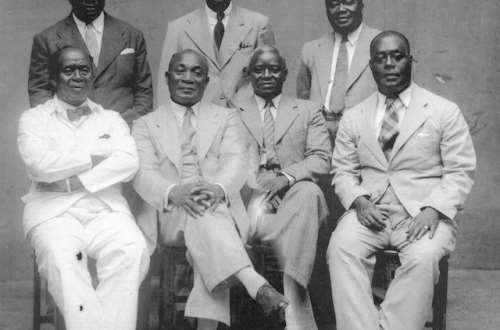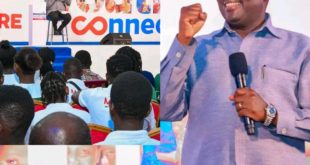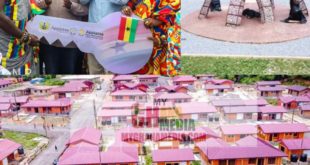The long held history that “The Big Six” formed the very first political party on the shores of the then Gold Coast and named it the United Gold Coast Convention (UGCC) is but a distorted history.
For years, generations have been taught in basic schools through to the University that the foundation for Ghana’s political party system was laid by the UGCC, but this appears to be untrue as several other parties existed before the UGCC.
In his latest article, the well-recognized Dr Nii Moi Thompson has shed light on Ghana’s true political history in snippets.
A paragraph of his article addresses the myth.
Myth No. 3: UGCC was the first political party in the Gold Coast.
Fact: The earliest known political parties (for municipal, not national, elections) were mainly the Accra Rate Payers Association and the Ga Manbii (Ga Nationalist) Party of Kojo Thompson in the 1920s. Lesser-known parties, such as the Asene Koo Wulu Party, later emerged in Accra and other municipalities like Cape Coast and Sekondi in the 1930s; never in Abuakwa, Danquah’s hometown. By the time the UGCC was founded in Saltpond in 1947, there were already other (if generally inactive) parties, particularly, the Gold Coast People’s League and the Gold Coast National Party. As a result, the name originally proposed by the founders was changed from Gold Coast People’s Party (GCPP) to United Gold Coast Convention (UGCC), to rein in the other parties.
Read below full article:
Beware, the tribal supremacists: Myths of J.B. Danquah and the Big Six
As expected, the president’s recent suggestion that the University of Ghana might be renamed after his late uncle, Dr. J.B. Danquah, the Gold Coast lawyer and “nationalist,” has provoked a firestorm of criticism from a public that has clearly had enough of the tribal-supremacist agenda of the president and his kinsmen.
And none of them have articulated the rationale behind this agenda more brazenly than a relative of the president, lawyer Samuel Atta Akyea, who three years ago said the following on the television programme, Good Evening Ghana:
“If you remove the role of the Akyem people from the history of this country, we won’t have a history… The guy who named this country is from Akufo-Addo’s background. The one who wanted Ghana called Ghana… [was] J. B. Danquah….” Mr. Akyea went on to cite the Big Six, the leaders of the United Gold Coast Convention (UGCC) who were arrested by the British colonialists after the 1948 riots that accelerated the independence process, and reminded viewers that the president’s father, among the six, “was one of the individuals who are acclaimed as the pioneers of our independence.”
With this crude concoction of facts and fiction, they tend to believe that they own the country and can do as they please. Textbooks, for instance, have been doctored and Danquah given disproportionate prominence in Ghana’s history.
This peasant aristocracy sense of entitlement, especially among people occupying national offices, is a threat to social cohesion and national development. So let us demolish forthwith a few myths about J.B. Danquah and the Big Six, and tackle other aspects of Ghanaian history that the tribalists have bastardised to drive this dangerous ideology of tribal supremacy. (For the record, I condemn the term “Akyem mafia,” or any term that demonises an entire tribe for the folly of a few).
Myth No. 1: Danquah’s research linked the Akan of Ghana to the ancient Ghana Empire.
Fact: That credit goes to Rev. J. B. Anaman, of Anomabo and Sekondi, whose research took place in 1895, the year Danquah was born.
Myth No. 2: Danquah founded the United Gold Coast Convention (UGCC).
Fact: Danquah himself described George Alfred (Paa) Grant, the wealthy Gold Coast merchant, as the “architect and founder of the UGCC.”
Myth No. 3: UGCC was the first political party in the Gold Coast.
Fact: The earliest known political parties (for municipal, not national, elections) were mainly the Accra Rate Payers Association and the Ga Manbii (Ga Nationalist) Party of Kojo Thompson in the 1920s. Lesser-known parties, such as the Asene Koo Wulu Party, later emerged in Accra and other municipalities like Cape Coast and Sekondi in the 1930s; never in Abuakwa, Danquah’s hometown. By the time the UGCC was founded in Saltpond in 1947, there were already other (if generally inactive) parties, particularly, the Gold Coast People’s League and the Gold Coast National Party. As a result, the name originally proposed by the founders was changed from Gold Coast People’s Party (GCPP) to United Gold Coast Convention (UGCC), to rein in the other parties.
Myth No. 4: The Big Six were the architects of the 28th February 1948 demo that propelled Ghana’s independence movement.
Fact: George Padmore, Kwame Nkrumah’s political advisor, stated in his book, The Gold Coast Revolution, that the Big Six did “not” initiate the demonstration. Nkrumah was away from Accra on the 28th , and Danquah and the other four initially condemned the ex-service men for the violence that had been instigated by the reckless shooting of unarmed demonstrators by a trigger-happy British officer named Colin Imray. The British arrested the six politicians – Kwame Nkrumah, Ebenezer Ako-Adjei, Edward Akufo-Addo, J.B. Danquah, William Ofori-Atta, and Emmanuel Obetsebi-Lamptey – more for their UGCC work than any direct involvement in the events of 28th February.
Who then was the architect of 28th February? That credit goes mainly to Mr. B. E. A Tamakloe, general secretary of the Ex-servicemen’s Union, who negotiated the demonstration with the governor; to whom the governor addressed all letters; and in whose name the permit for the demonstration was issued. He was supported by five other people, according to the Watson Commission’s report, making them the Real Big Six, but the five were not named.
However, all eight executives of the Union who planned the demo were named, giving us the Big Eight: (1) B. E. A. Tamakloe; (2) S. A. Codjoe; (3) R. T. Dodoo; (4) J. S. Laryea; (5) R. P. Craig; (6) F. L. Adjei; (7) J. D. Ankrah; and (8) G. E. Lutterodt. We need a proper history of Ghana.
And then there were the 29 martyrs who died from the disturbances of the 28th and the days that followed, including Sgt. Cornelius Nii Adjetey; Corporal Patrick Attipoe, and Private Odartey Lamptey, who were murdered by Imray. The Big Six, as a group, were accidental beneficiaries of history, their individual contributions to the nationalist movement notwithstanding.
Myth No. 5: Ashantis did not play any role in the independence movement because they don’t appear in the Big Six.
Fact: Ghana’s history is bigger than the Big Six, despite efforts by Danquah’s descendants to make the Big Six (and, within the Big Six, their relatives) the alpha and omega of our history. Krobo Edusei of the Ashanti Youth Association (AYA) was the chairman of the Kumasi committee of the nation-wide Anti-Inflation Campaign that was organised by Mantse Nii Kwabena Bonne (a chief of both Osu and Techiman, then part of Ashanti) in 1948.
When the Big Six were incarcerated in Kumasi, AYA plotted to storm the prison and free them, prompting the governor to whisk them to the Northern Territories, under stricter security, for fear that the hard-nosed AYA members may still make their way up north. Edusei later served nine months in jail for his political activism alongside Nkrumah. The AYA, in its militancy, had also demanded “self-government within the next five years,” compared to the UGCC’s gradualist approach of self-government “in the shortest possible time”.
The AYA, the Osu Youth Association, and the Sekondi Youth Association were among the youth groups that dragged Nkrumah from the UGCC and forced him to form the Convention People’s Party (CPP), which led Ghana to independence. They were the original foot soldiers! The proposed name for their new party was Ghana People’s Party, but Nkrumah asked that “Ghana” be reserved for independence and replaced it with “Convention” to show continuity, at least in name, from the UGCC.
Myth No. 6: Danquah named the Gold Coast Ghana.
Fact: That was simply impossible, as by 1957 Danquah’s political career was effectively over (he and Ofori-Atta having lost their seats to the CPP in the 1954 and 1956 elections). Only Nkrumah as prime minister in 1957 was in a position to propose that name, and he did. Danquah and the others criticised Nkrumah for choosing the name Ghana, and in his autobiography Nkrumah was forced to defend his choice.
Danquah, however, had a weird obsession for naming places, like the president does today. He had proposed, without any consultations, that the Northern Territories be renamed Fergusonia, after Ekem Ferguson, the surveyor from Anomabo who had done much work in the North. The idea was rejected by the British, much like his previous suggestion to rename the Gold Coast Akanland, and later Akan-Ga, when he was reminded that there were more than Akans in the colony. (He, like the president today and his fellow tribalists, was married to a Ga woman).
His most “valiant” name-changing effort was his suggestion after the 1948 riots that he and his relatives be put in charge of the Gold Coast, under the name Ghanaland. The idea of course was laughed off by the British. He pioneered the tribalism that his inward-looking descendants are now perfecting with national resources. (Remember the president’s statement, “Yen Akanfo” during his desperate struggle to win power – and destroy the country?)
Myth No. 7: Danquah was the “doyen of Gold Coast politicians”.
Fact: The Watson Commission described him as such but suggested that this was before Nkrumah came on the scene. Thus, in the 1951 election, Nkrumah won over 95% of the votes (from prison!) whilst Danquah scraped through with only 53% (and Ofori-Atta with 51%) in Abuakwa. In the 1954 election, both Danquah and Ofori-Atta, running on Busia’s Ghana Congress Party (GCP) after the collapse of the UGCC in 1951, lost to CPP upstarts, despite threats from the Okyenhene to deport anyone who voted for the CPP. Of the 104 seats, the GCP won only one – by Busia, who squeezed through his Wenchi constituency with an 11-vote victory over his CPP rival.
Danquah and Ofori-Atta again lost the 1956 elections, exposing the limits of Danquah’s purported doyenness. He was a novice when it came to political organisation and electioneering, no match for Nkrumah, the consummate organiser, strategist, orator, and man of the people. Whilst Nkrumah wore batakari, Danquah preferred his three-piece suit in the hot African sun, making him a stranger to his own people.
Myth No. 8: Kwame Nkrumah hated Ashantis.
Fact: The opposite was true. Nkrumah loved Ashanti and Ashanti loved him (and the CPP) back. One of the most fanatical members of the CPP was an Asante woman from Bekwai (but lived in Kumasi) who named herself Ama Nkrumah (the female version of Kwame Nkrumah) and pledged support to Nkrumah and the CPP with her blood. The CPP swept five of the six seats in the 1950 Kumasi municipal elections (6,210 votes versus 50 for the opposition), and would have won the sixth seat had it not been for a technical disqualification.
Ashanti was the first to benefit from Nkrumah’s Accelerated Education Programme of 1951, with the establishment of the Kwame Nkrumah University of Science and Technology and Opoku Ware Secondary School in 1952, among others. Despite the terror attacks by the National Liberation Movement (NLM) in 1956 against CPP members, which led to an exodus of CPP refugees from Ashanti, the CPP won 8 seats in Ashanti, compared to 12 for the NLM in the 1956 election. The CPP won 43% of the total Ashanti vote and claimed NLM strongholds like Obuase and Asante Akyem hands down.
Suffice it to say that there is more to Ghana’s history than the Big Six, in whose shadow some now seek relevance and pre-eminence for their dead relatives. It appears that without the Big Six, they are nothing, unlike Nkrumah, whose legacy goes beyond the Big Six and stands on its own.
The public’s swift and no-nonsense rejection of the president’s loose talk about renaming UG after his uncle is a pointed reminder that Ghanaians would not tolerate the bastardisation of their history by any group or tribe, no matter how powerful or privileged they might feel.
Power, after all, in a democracy like Ghana’s, is fleeting. A word to the wise….
The writer, Nii Moi Thompson, is the former Director-General of the National Development Planning Commission
THANK YOU for constantly reading stories on MyGhanaMedia.com, news publishing website from Ghana. Kindly like, follow, comment and SHARE stories on all social media platforms for more entertaining updates!
Follow us on Twitter: https://twitter.com/
Source: MyGhanaMedia.com
There are four types of content published on MyGhanaMedia.com daily: curated content; syndicated content; user-generated content; and original content.
 MYGHANAMEDIA.COM Best Source Of Latest News
MYGHANAMEDIA.COM Best Source Of Latest News





